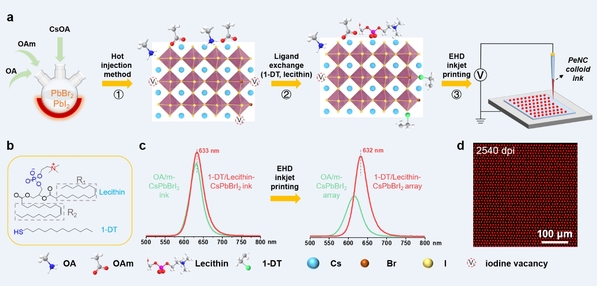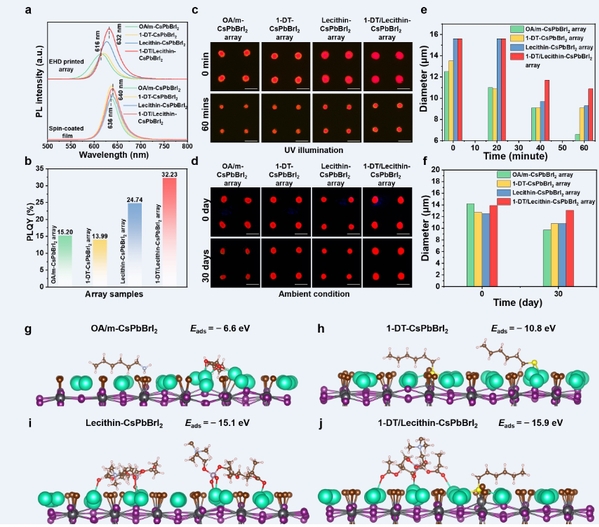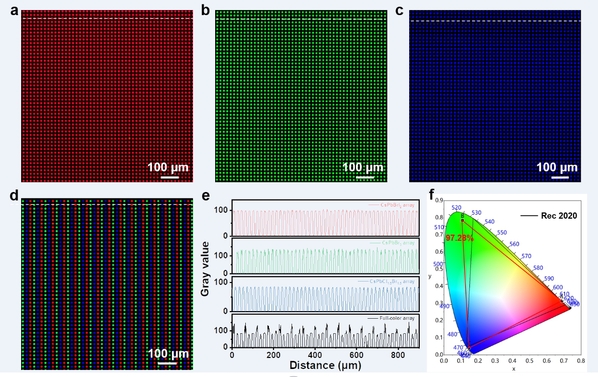

林岳、王树立课题组:双配体钝化红光钙钛矿墨水EHD打印色转换层阵列(2540 dpi)用于micro-LED近眼显示
一、成果简介
红色钙钛矿纳米晶体的稳定性不足仍然是制约其图案化应用的关键问题。本文引入正十二硫醇和卵磷脂双配体钝化策略来稳定CsPbBrI2纳米晶体,抑制其在高压EHD喷墨打印过程中的卤素离子迁移。与原始油酸油胺配体和单一正十二硫醇或卵磷脂配体钝化的样品相比,双配体钝化的CsPbBrI2纳米晶体墨水EHD打印的红色阵列具有最高的PL强度、最小的PL峰值波长蓝移、最优的环境稳定性和耐紫外光辐照稳定性,最小像素尺寸为5 μm,最高打印分辨率达到2540 dpi,红光阵列色坐标位于(0.687,0.313),色纯度达到99.9%。结合蓝色和绿色钙钛矿纳米晶体墨水,在黑色光刻胶模板上成功打印红绿蓝单色和全彩化色转换层阵列,色域达到Rec.2020的97.28%。
本文的第一作者为厦门大学电子学院博士生杨晓和王树立助理教授,通讯作者为林岳副教授和陈忠教授。
二、图文导读

Figure 1. (a) Schematic diagram of preparation of red PeNCs ink by ligand exchange and EHD inkjet printing process. (b) Chemical structural formula of ligands. (c) PL spectra of ink and printed arrays before and after passivation of dual ligands. (d) Demonstration of high-resolution dot array printed by EHD inkjet printing, with spatial resolution of 2540 dpi and dot diameter of 5 μm.

Figure 2. (a) TEM, HRTEM images and particle size distribution statistic graphs. (b) FTIR spectra, (c) XRD pattern of OA/m-CsPbBrI2 NCs, 1-DT-CsPbBrI2 NCs, Lecithin-CsPbBrI2 NCs and 1-DT/Lecithin-CsPbBrI2 NCs.

Figure 3. (a) UV-vis absorption spectra and PL spectra, (b) PLQY, and (c) Time-resolved PL decay curves of OA/m-CsPbBrI2 NCs ink, 1-DT-CsPbBrI2 NCs ink, Lecithin-CsPbBrI2 NCs ink and 1-DT/Lecithin-CsPbBrI2 NCs ink. (d) PL spectra of OA/m-CsPbBrI2 NCs ink, 1-DT-CsPbBrI2 NCs ink, Lecithin-CsPbBrI2 NCs ink and 1-DT/Lecithin-CsPbBrI2 NCs ink diluted solution after 2 h in ambient conditions. (Inset: The images of four samples under natural light and UV illumination) (e) Normalized PL intensity of OA/m-CsPbBrI2 NCs ink, 1-DT-CsPbBrI2 NCs ink, Lecithin-CsPbBrI2 NCs ink and 1-DT/Lecithin-CsPbBrI2 NCs ink after adding different volumes of ethanol.

Figure 4. (a) PL spectra of EHD inkjet printed arrays and spin-coated films prepared from OA/m-CsPbBrI2 NCs ink, 1-DT-CsPbBrI2 NCs ink, Lecithin-CsPbBrI2 NCs ink and 1-DT/Lecithin-CsPbBrI2 NCs ink. (b) PLQY of OA/m-CsPbBrI2 array, 1-DT-CsPbBrI2 array, Lecithin-CsPbBrI2 array and 1-DT/Lecithin-CsPbBrI2 array. (c) The morphology and (e) diameter changes of EHD printed OA/m-CsPbBrI2 array, 1-DT-CsPbBrI2 array, Lecithin-CsPbBrI2 array and 1-DT/Lecithin-CsPbBrI2 array during continuous UV illumination for 60 minutes. (d) The morphology and (f) diameter changes of EHD printed OA/m-CsPbBrI2 array, 1-DT-CsPbBrI2 array, Lecithin-CsPbBrI2 array and 1-DT/Lecithin-CsPbBrI2 array before and after 30 days under ambient conditions (the scale bar in (c) and (d) is 25 μm).The adsorption energy of (g) OA/m, (h) 1-DT, (i) lecithin, (j)1-DT and lecithin on the surface of CsPbBrI2 NCs.

Figure 5. Array printing demonstration of (a) 1-DT/Lecithin-CsPbBrI2 NCs array, (b) CsPbBr3 NCs array, (c) CsPbCl1.5Br1.5 NCs array and (d) tri-color PeNCs arrays on black photoresist template. (e) Gray value and (f) color gamut of as-printed arrays.
三、论文信息
Dual-Ligand Red Perovskite Ink for Electrohydrodynamic Printing Color Conversion Arrays over 2540 dpi in Near-Eye Micro-LED Display
Xiao Yang#, Shuli Wang#, Yaqi Hou, Yuhui Wang, Tianqi Zhang, Yihang Chen, Guolong Chen, Chenming Zhong, Xiaotong Fan, Xuemin Kong, Tingzhu Wu, Yijun Lu, Yue Lin*, and Zhong Chen*
Cite this: Nano Lett. 2024, XXXX, XXX, XXX-XXX
Publication Date: February 26, 2024
https://doi.org/10.1021/acs.nanolett.3c04927